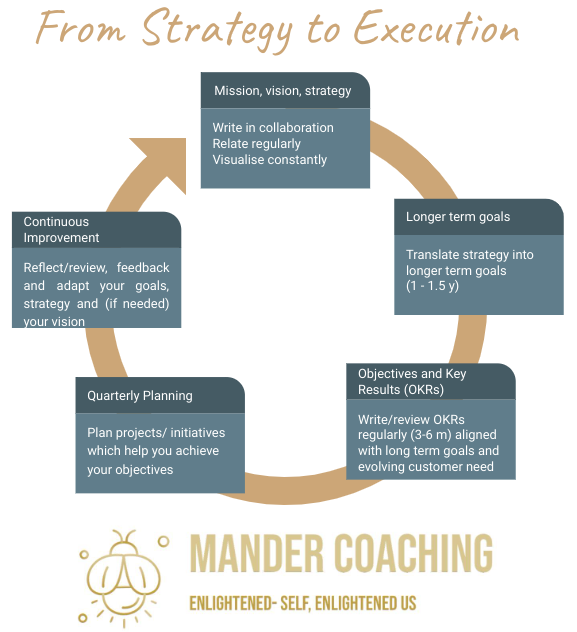From Strategy to Execution in 5 steps made simple
Two days ago, I wrote an article which gives ideas on how to start to collaboratively draft/ review your company mission, vision and strategy. I also shared thoughts from my experience on the benefits of relating regularly to the company mission, vision and strategy. Scroll down to the bottom right in case you have missed How far you can see = How far you can get.
The focus of today's article is how you can actually translate this strategy from paper to execution in a way that supports the success of your business. Let's assume that you have already made some great work on identifying your mission, vision and strategy. How do you further align your strategic goals with the daily activities of every employee? This is one of the most critical leadership skills, if you ask me, and is key for any organisation to thrive as opposed to trying to survive. Here are 5 steps made simple which will help you do that:
Visualise and communicate your mission, vision and strategy regularly. Market it to your external customers and your employees as if they are also your customers. Include it in the on-boarding process of your new employees. Make it visible and relate it day in and day out to what people do.
Translate your strategy into longer term goals for your organisation and the different departments/teams. Doing this will help you to make different important choices and business decisions. Are you wondering how far should the longer term goals go for? You can find various opinions on that. Some consultants would tell you 3-5 years, some will say 6 months. I find that in an ever changing environment where customer needs shift so quickly and competition is ever so innovative, a good horizon to translate your strategy into longer term goals would be 1 to 1.5 years. This golden middle gives you some stability as frequent changes of goals and direction can be such a wasteful activity and can drive both your employees and customers away and at the same time, this period is short enough to help you remain flexible.
A way to make sure that you adapt your long term goals and remain relevant is by having a regular review process of your objectives and measuring factually your success to understand if the choices you make really support your strategy. One very helpful way to do that is the Objectives and Key Results (OKRs) concept. I won't go into details on the model today. What is important to mention is how the OKRs support your long term goals. You can translate your long term goals (1 - 1.5 years) into short and medium term Objectives, define how you will measure that you are achieving them and have a regular writing/review process (e.g. each quarter) to check if your OKRs still support your long term goals and strategy. Depending on the evolution some Objectives (O) may be set for a longer period of time then a quarter with, for example, difference in your Key Results (KR). There are some big names you can follow for more inspiration on OKRs: Christina Wodtke, Jeff Gothelf, John Doerr. If you wish to give it a go, I will be happy to train your team and help you write/ review your OKRs in a way that works for you and supports the successful implementation of your strategy.
Once you have identified your Objectives and how you would like to measure your success for the quarter, it is time to plan. I advise you to plan your different projects and initiatives during the quarter like hypotheses/ experiments in your roadmap which have the potential to help you achieve your ambitious objectives. Lots of companies do the opposite: they set their mind on their roadmap and activities that they would like to do and then they fit their objectives based on that which is doing things backwards and only works based on hazard and luck. This way does not align with your strategy, limits your possibilities and therefore, simply does not support the success of your business.
You are almost there but not quite there yet. Nothing of this would work unless you have a continuous improvement process on the different levels of your organisation and repeatable review cycles which feeds back into your goals, strategy and even into the purpose of your organisation. Therefore, I`d like to visualise this as a closed loop.
There you go! Does this make sense to you? What have you tried so far that worked/ did not work for you? What are you tempted to do differently?
Wishing you success and remaining available if you wish that we strategize and execute together!

